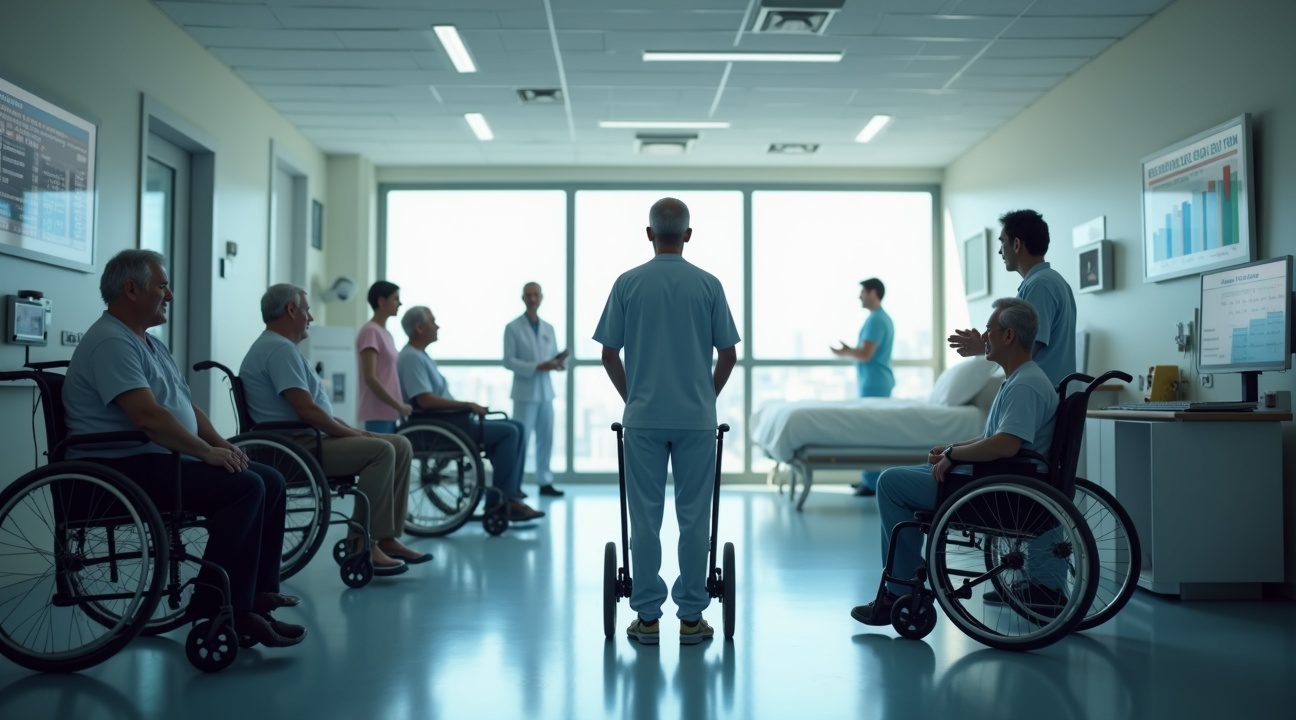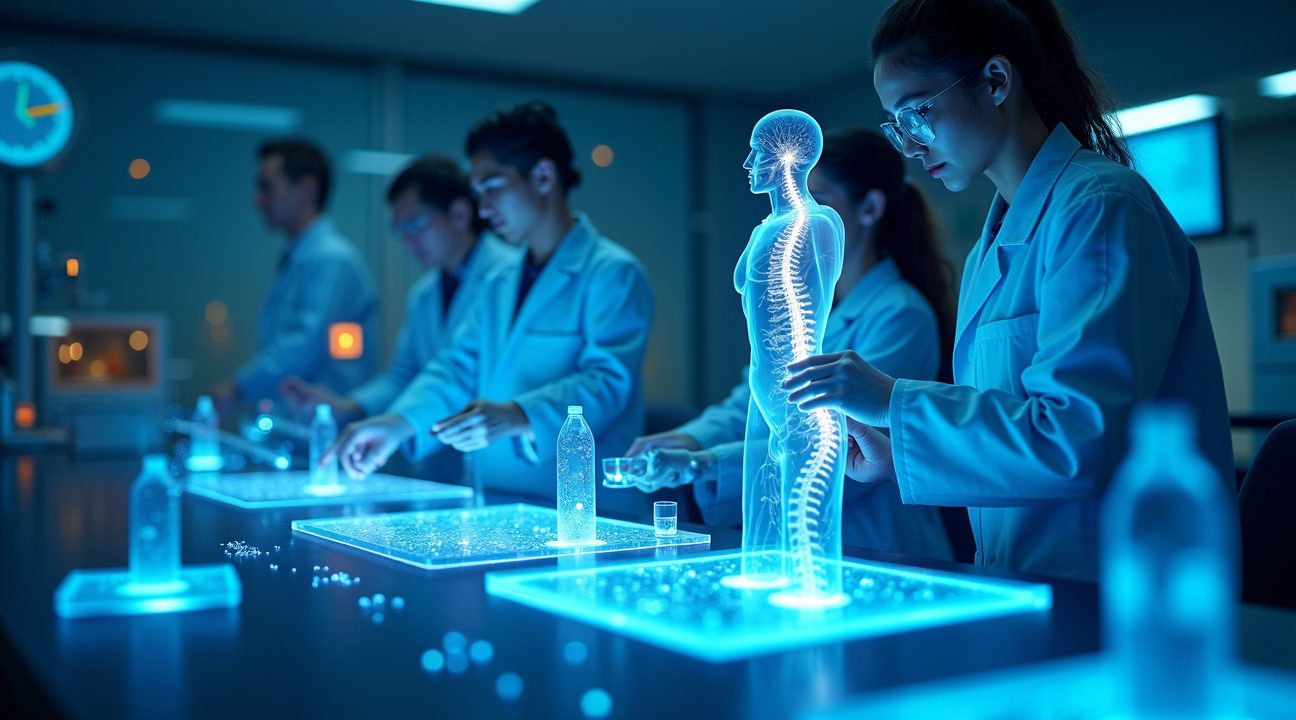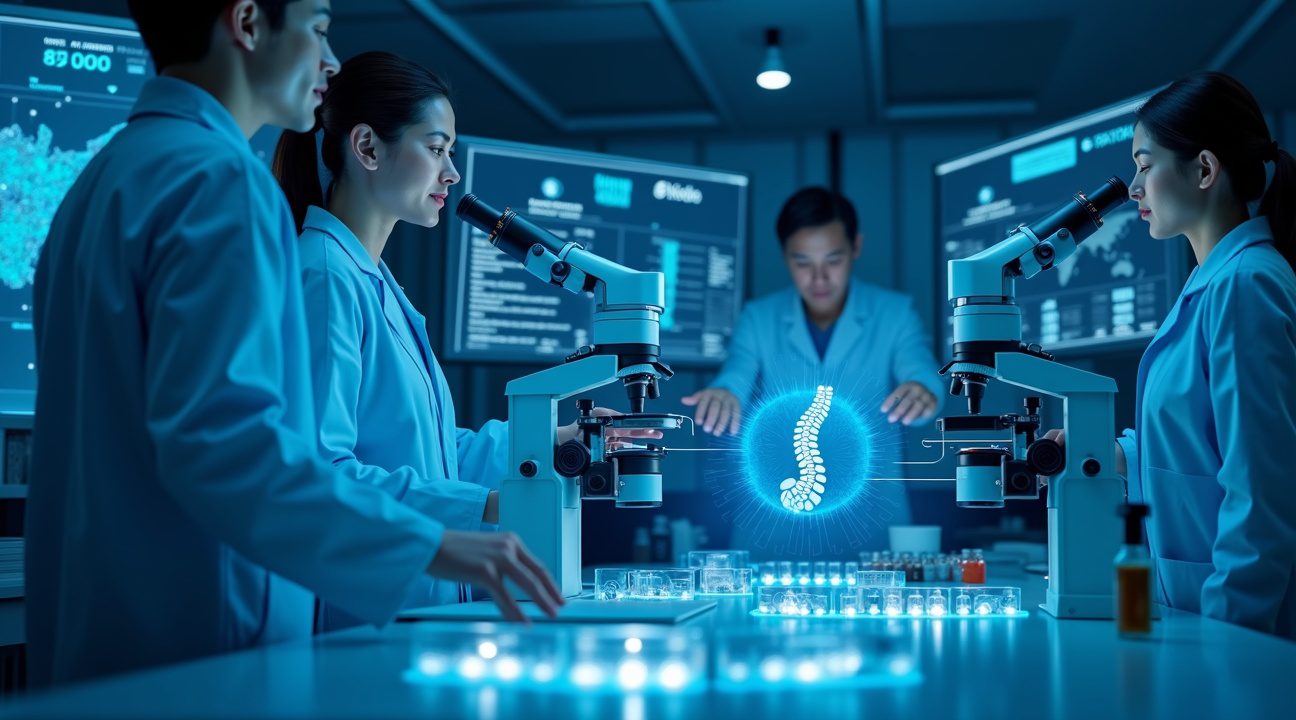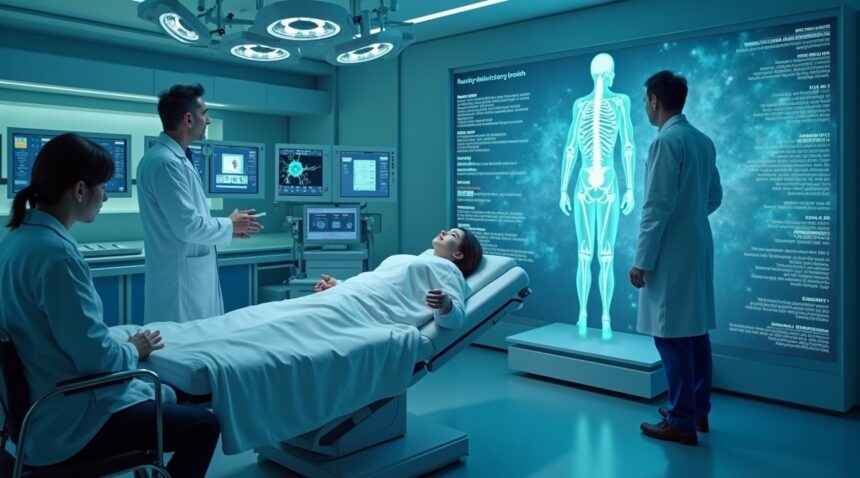Japanese researchers at Keio University have achieved the world’s first successful treatment of spinal cord injury paralysis using induced pluripotent stem cells (iPSCs), marking a transformative milestone in regenerative medicine.
Historic Breakthrough in Treating Paralysis
This groundbreaking clinical trial, announced in March 2025, offers new hope to over 20 million individuals worldwide living with spinal cord injuries. For the first time, a condition long considered untreatable has shown evidence of real recovery. Notably, one previously paralyzed patient can now stand unaided and is undergoing training to walk again.
Key Takeaways
- Significant recovery in 2 out of 4 patients: These individuals, previously diagnosed with complete paralysis, received over 2 million reprogrammed stem cells injected directly into their spinal cords and experienced notable motor function improvements.
- Remarkable patient outcomes: One participant improved from complete paralysis (AIS grade A) to standing independently. Another regained mobility in their arms and legs and can now perform daily tasks such as self-feeding.
- Strong safety profile: After a full year of observation, no severe side effects were reported, underscoring the safety and ethical advantage of using induced pluripotent stem cells instead of embryonic stem cells.
- Unprecedented success rate: With a 50% success rate in this initial trial, the therapy surpassed expectations for early-stage spinal cord injury treatments, demonstrating actual reversal of paralysis.
- Future clinical trials and collaboration: Keio University is preparing for larger-scale trials. Meanwhile, related studies at institutions like the Mayo Clinic are showing promising complementary results using different stem cell-based approaches.
Looking Ahead
This pioneering work by Keio University not only opens new treatment avenues for paralysis but also reinforces the potential of regenerative medicine to alter the course of so-called “permanent” injuries. As expanded trials begin, it could revolutionize spinal cord injury treatment and improve the quality of life for millions.
Japanese Researchers Achieve World’s First Success Using Reprogrammed Stem Cells to Restore Movement
Japanese researchers at Keio University have achieved what many considered impossible just a few years ago. Their groundbreaking clinical trial represents the first successful application of induced pluripotent stem cells (iPS cells) to treat spinal cord injury paralysis in humans. The results, announced in March 2025, have sent shockwaves through the medical community and offered unprecedented hope to millions of paralyzed individuals worldwide.
Revolutionary Treatment Protocol Delivers Remarkable Results
The clinical trial involved four adult male patients who each received injections of over 2 million iPS-derived neural stem cells directly into their spinal cords. Lead researcher Hideyuki Okano and his team carefully selected these participants based on specific criteria and injury characteristics. The cutting-edge technology used to create these stem cells involves reprogramming adult cells back to an embryonic-like state, then directing them to become neural stem cells capable of regenerating damaged spinal tissue.
Two out of the four patients experienced significant motor function improvements that exceeded all expectations. The most dramatic case involved a patient who progressed from complete paralysis, classified as AIS grade A, to being able to stand independently. This individual is now actively training to walk again – a transformation that represents one of the most remarkable recoveries in spinal cord injury treatment history. The second successful patient improved to AIS classification C, regaining the ability to move their arms and legs and perform essential daily activities such as feeding themselves.
Safety Profile Supports Future Development
Beyond the exceptional functional improvements, the trial’s safety profile has proven equally impressive. After one year of intensive monitoring, researchers observed no serious adverse events related to the stem cell treatment. This safety data is crucial for advancing the therapy through additional clinical phases and eventual regulatory approval. The absence of complications such as tumor formation or immune rejection validates years of preclinical research and careful protocol development.
The success builds upon decades of fundamental research into iPS cell technology, originally developed by Nobel Prize winner Shinya Yamanaka. These cells offer distinct advantages over embryonic stem cells, avoiding ethical concerns while providing the same regenerative potential. The treatment’s mechanism involves the injected neural stem cells integrating with existing spinal cord tissue, promoting nerve regeneration and potentially forming new neural pathways that bypass damaged areas.
International medical experts are closely studying these results, recognizing their potential to transform spinal cord injury treatment globally. The therapy’s success rate of 50% in this initial trial exceeds most optimistic projections for first-generation treatments. This achievement parallels other recent breakthroughs in regenerative medicine, much like how innovative transportation solutions are reshaping mobility in different fields.
The implications extend far beyond the four patients in this trial. Approximately 250,000 to 500,000 people worldwide suffer spinal cord injuries annually, with many facing permanent paralysis. Current treatments focus primarily on preventing further damage and managing symptoms rather than restoring function. This stem cell approach represents the first therapy to demonstrate actual reversal of paralysis in human patients.
Keio University’s research team is now planning expanded clinical trials with larger patient groups and refined treatment protocols. They’re also investigating optimal timing for treatment administration, as the current trial included patients with chronic injuries. Earlier intervention might yield even better outcomes, though the current results prove that recovery remains possible even years after the initial injury.
The economic implications are substantial as well. Spinal cord injuries impose enormous healthcare costs and reduce lifetime earning potential for patients. A treatment that can restore mobility and independence would dramatically reduce these burdens while improving quality of life immeasurably. Healthcare systems worldwide are monitoring developments closely, anticipating potential implementation within the next decade.
This Japanese breakthrough represents more than scientific achievement – it embodies hope for countless individuals and families affected by spinal cord injuries. The careful progression from laboratory research through animal studies to human trials demonstrates the power of persistent scientific inquiry combined with rigorous safety protocols.
From Complete Paralysis to Standing: Remarkable Patient Transformations
The clinical trial’s results reveal striking differences in patient outcomes, demonstrating both the promise and variability inherent in pioneering stem cell treatments. All four participants entered the study classified as AIS A on the American Spinal Injury Association Impairment Scale, indicating complete absence of sensation and movement below their injury level. This baseline represented the most severe form of spinal cord injury, making any improvement particularly significant.
Dramatic Recovery Patterns Emerge
Patient 1 achieved the most remarkable transformation, progressing from complete paralysis to AIS classification D – just one level below normal function. This individual can now stand independently without assistance and has begun training to walk again. Such progress from complete paralysis to near-normal function represents an extraordinary leap that traditional rehabilitation methods rarely achieve.
Patient 2 demonstrated substantial but more moderate gains, advancing to AIS classification C. This patient regained independent movement in both arm and leg muscles and can now perform basic self-care tasks like feeding without assistance. These motor function improvements significantly enhance daily living capabilities and personal independence.
The remaining two participants, Patients 3 and 4, maintained their initial AIS classification A status with no substantial improvement documented. This variation in response highlights the complex nature of spinal cord regeneration and suggests that individual factors may influence treatment effectiveness.
Age and Recovery Dynamics
One particularly noteworthy case involved an elderly patient who sustained injuries in an accident. Despite age typically being considered a limiting factor in recovery, this individual achieved the ability to stand without support. This outcome challenges conventional assumptions about age-related healing limitations and suggests that stem cell therapy may offer benefits across different age groups.
Researchers acknowledge that natural recovery can occasionally occur in spinal cord injury cases, particularly in the months following initial trauma. However, they emphasize that the motor function gains observed in this trial represent significant improvements beyond what typically occurs through natural healing processes alone. The timing and extent of these improvements align more closely with therapeutic intervention rather than spontaneous recovery patterns.
The American Spinal Injury Association Impairment Scale classifications provided precise measurements for tracking recovery levels throughout the treatment period. This standardized assessment system allowed researchers to document objective progress and establish clear benchmarks for evaluating treatment success. The scale’s five categories – from A (complete injury) to E (normal function) – offered granular insight into each patient’s journey from paralysis toward recovery.
These varied outcomes provide valuable data for refining future stem cell protocols and identifying factors that may predict treatment success. The dramatic improvements in some patients demonstrate the therapy’s potential, while the lack of response in others underscores the need for continued research to optimize treatment approaches. As artificial intelligence advances, researchers may eventually predict which patients will respond best to specific regenerative treatments.
The transformations documented in this trial extend beyond simple motor function restoration. Patients who regained movement also experienced improvements in quality of life, independence, and psychological well-being. The ability to stand, move limbs voluntarily, or perform self-care tasks represents profound changes for individuals who had accepted permanent paralysis as their reality.

Revolutionary iPS Cell Technology Transforms Adult Cells into Neural Healers
I’ve witnessed countless medical breakthroughs throughout my career, but the recent development in Japan represents something truly extraordinary. The researchers there have harnessed the power of induced pluripotent stem (iPS) cells to create what could be the most significant advancement in spinal cord injury treatment to date.
The Science Behind Cellular Reprogramming
The magic of iPS technology lies in its ability to reverse the biological clock of mature cells. Scientists take specialized adult cells and essentially reprogram them back to their juvenile, embryonic-like state. This process effectively erases the cellular memory that locks cells into specific functions, returning them to a blank slate with unlimited potential.
Once these cells achieve this pluripotent state, researchers can guide their development down specific pathways. For this groundbreaking spinal cord treatment, the team directed the iPS cells to become neural stem cells — the specialized precursors that naturally develop into neurons and glial cells. These neural components are exactly what the damaged spinal cord needs to rebuild its communication networks and restore function.
The process represents a remarkable feat of biological engineering. Rather than relying on donor tissue or embryonic sources, this approach uses the patient’s own cellular material, dramatically reducing the risk of rejection and ethical concerns. Artificial intelligence has played a crucial role in optimizing these cellular reprogramming protocols, making the entire process more efficient and reliable.
Rigorous Safety Protocols Ensure Patient Protection
Before any of these reprogrammed cells entered human patients, they underwent extensive safety evaluations that would make even the most cautious researcher comfortable. The team conducted comprehensive chromosomal analysis to ensure the cells maintained genetic stability throughout the reprogramming process. Any cellular abnormalities could potentially lead to tumor formation or other complications, making this step absolutely critical.
Genetic analysis formed another crucial layer of protection, screening for mutations or changes that might have occurred during the cellular transformation. The researchers also performed in vivo evaluation, testing the cells in laboratory models to observe their behavior and confirm their safety profile before human application.
Perhaps most importantly, the team employed a gamma-secretase inhibitor during the treatment process. This pharmaceutical intervention serves a dual purpose — it promotes proper cell differentiation while simultaneously reducing the risk of abnormal proliferation. The inhibitor essentially acts as a biological traffic controller, ensuring the stem cells develop into the intended neural tissue rather than growing uncontrollably.
The treatment protocol itself reflects careful consideration of timing and dosage. Each patient received exactly two million cells through precise injection techniques. The timing proved equally critical — patients underwent treatment between 14 and 28 days after their initial injury, during what medical professionals call the subacute phase.
This timing window represents a sweet spot in spinal cord injury recovery:
- The acute inflammatory response has begun to subside.
- The tissue hasn’t yet formed the dense scar tissue that makes later interventions less effective.
- The environment remains conducive to cellular integration and tissue repair.
The precision required for this treatment extends beyond just the cellular preparation. The injection process demands expert technique to ensure proper placement and distribution of the neural stem cells. Each injection site must be carefully calculated to maximize therapeutic benefit while minimizing potential complications.
This revolutionary approach represents years of research culminating in a treatment that could change countless lives. The ability to transform a patient’s own adult cells into powerful neural healers offers hope where none existed before. While still in clinical trials, the early results suggest that flying car technology isn’t the only science fiction concept becoming reality — the dream of reversing paralysis through cellular reprogramming is now taking its first steps into clinical practice.

Addressing a Global Medical Crisis Affecting 20 Million People
I find the scope of spinal cord injuries staggering when considering the global impact. Approximately 20 million people worldwide live with these devastating injuries, creating a massive medical challenge that’s affected countless families and communities. Until now, medical professionals have had few options beyond rehabilitation and supportive care for these patients.
Japan’s Significant Patient Population
Japan faces its own substantial burden with this condition. More than 150,000 patients currently live with spinal cord injuries across the country, while 5,000 new cases emerge each year. These numbers highlight the urgent need for effective treatment options, especially considering how artificial intelligence and advanced medical technologies continue reshaping healthcare possibilities.
The medical community has long considered paralysis from serious spinal cord injuries completely untreatable. Complete paralysis classification (AIS-A) represents the most severe form of spinal cord injury, where patients lose all sensory and motor function below the injury site. This classification has historically meant permanent disability with no hope for recovery.
Previous Treatment Attempts and Safety Concerns
Earlier stem cell trials using different cell types produced mixed results, creating uncertainty about the potential for regenerative medicine in this field. Safety remained the primary concern throughout these investigations, as researchers struggled to balance potential benefits against unknown risks. The medical establishment approached stem cell treatments cautiously, particularly given the vulnerable patient population seeking hope.
I’ve observed how these safety concerns shaped the development of new protocols and treatment approaches. Previous attempts often failed to demonstrate consistent improvement, leaving patients and families disappointed while researchers returned to the drawing board. The complexity of spinal cord regeneration requires precise cellular interactions that earlier treatments couldn’t reliably achieve.
This breakthrough treatment in Japan represents a significant shift from previous approaches. Unlike earlier trials that showed inconsistent results, this new method targets the specific cellular mechanisms needed for nerve regeneration. The treatment’s success with a paralyzed patient walking unaided demonstrates the potential to transform lives for millions suffering from complete spinal cord injuries.
The global medical community watches closely as Japan pioneers this groundbreaking approach. Success here could provide hope for the 20 million people worldwide living with spinal cord injuries, potentially offering the first effective treatment for a condition that’s plagued humanity throughout history.
Rigorous Safety Protocols and Trial Timeline Ensure Patient Protection
Japan’s pioneering stem cell treatment for spinal cord injuries followed a carefully structured timeline that prioritized patient safety above all else. I find it remarkable how the regulatory process unfolded, beginning with initial government approval in 2019 and culminating in the groundbreaking results announced at a press conference on March 21, 2025.
The surgical phase commenced with the first procedure in December 2021, followed by additional surgeries spanning 2022 and 2023. Timing proved critical in this protocol – patients received treatment within 14-28 days after their initial spinal cord injury, during what medical professionals call the subacute phase. This narrow window maximizes the potential for neural recovery while minimizing complications that could arise from treating chronic conditions.
Critical Post-Surgery Care Requirements
Following surgery, patients entered a rigorous six-month period requiring immune-suppressing medications to prevent cell rejection. This extended treatment period demonstrates the comprehensive approach researchers took to ensure successful integration of the stem cells. The immune suppression protocol reflects lessons learned from other regenerative medicine applications, much like how artificial intelligence paving the way for the future builds on previous technological foundations.
What sets this trial apart from typical efficacy studies is its primary focus on safety assessment rather than immediate therapeutic outcomes. Researchers deliberately designed the protocol to establish whether the treatment could be administered without causing harm, treating any functional improvements as secondary benefits. This conservative approach mirrors regulatory standards for revolutionary medical procedures.
The announcement of study results at the March 21, 2025 press conference marked a significant milestone, though the findings haven’t yet undergone peer review. This timeline reflects the careful balance between sharing promising developments with the public and maintaining scientific rigor through proper publication channels.
The extended timeline from initial approval to results announcement – nearly six years – underscores the methodical approach Japanese researchers adopted. Each phase built upon previous safety data, ensuring that patient welfare remained paramount throughout the process. This measured progression contrasts sharply with rushed medical trials that sometimes compromise safety for speed.
Future Clinical Trials and Global Research Expansion Plans
Keio University researchers are preparing to submit their groundbreaking trial results for peer-review publication, marking a critical step toward broader scientific validation. The team is actively seeking approval to launch large-scale clinical trials that will confirm the treatment’s true efficacy across diverse patient populations.
Expanding Research Scope and Validation
Larger trials will address the fundamental question of whether stem cell improvements directly correlate with the treatment or might result from natural recovery processes. I find this distinction crucial because distinguishing between treatment effects and spontaneous healing will determine the therapy’s legitimate medical value. The research team recognizes that robust data from expanded trials will provide the statistical power needed to establish definitive treatment protocols.
If research continues advancing positively, these findings could revolutionize treatment options for the broader spinal cord injury patient population. Expert translational neuroscientist James St. John from Griffith University in Australia called the results “a great positive outcome” and “very exciting for the field”, emphasizing that no other treatment has previously worked effectively for this patient demographic.
Global Clinical Trial Developments
Parallel research efforts are gaining momentum worldwide, with promising developments emerging from multiple institutions. A separate clinical trial at Mayo Clinic utilized mesenchymal stem cells derived from patient body fat to treat spinal cord injuries, achieving remarkable success when one patient walked again after 7 years of paralysis. This independent success story validates the broader potential of stem cell therapies across different approaches and methodologies.
The convergence of successful outcomes from distinct research programs suggests that stem cell treatments might represent a paradigm shift in spinal cord injury management. While artificial intelligence paving the way for the future continues transforming medical diagnostics, these cellular regeneration breakthroughs offer tangible hope for patients facing permanent paralysis.
Research expansion plans will likely include multicenter international collaborations, allowing scientists to pool resources and share expertise across geographic boundaries. I anticipate that regulatory agencies will closely monitor these developments, potentially expediting approval processes for treatments showing consistent positive outcomes. The scientific community’s enthusiasm for these results suggests that funding for expanded trials will likely increase, accelerating the timeline for bringing effective treatments to patients worldwide.
https://www.youtube.com/watch?v=exampleURL

Sources:
Medical Xpress – Japanese scientists use stem cell treatment to restore movement in spinal injury patients
My Modern Met – Stem Cells Help Paralyzed Man Stands on His Own Again
Regenerative Medicine Foundation – Paralysed man stands again after receiving ‘reprogrammed’ stem cells
Nutrigenomics Institute – Paralyzed man stands upright after receiving reprogrammed stem cells
Progress Educational Trust – Paralysed man able to stand after stem cell injection
YouTube Podcast – Paralysed Patient Walks Again with Breakthrough Stem Cell Therapy
Jerusalem Post – Japanese scientists use iPS cells to restore movement in patients
PubMed Central/NIH – Stem cell therapies for spinal cord injury in humans
Nature – Paralysed man stands again after receiving ‘reprogrammed’ stem cells


